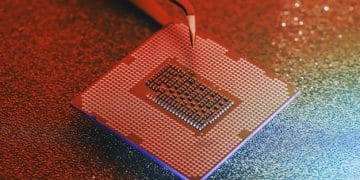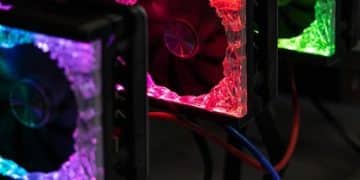Boost Gaming Performance: Does a Better PC Cooling System Give You 15% More FPS?
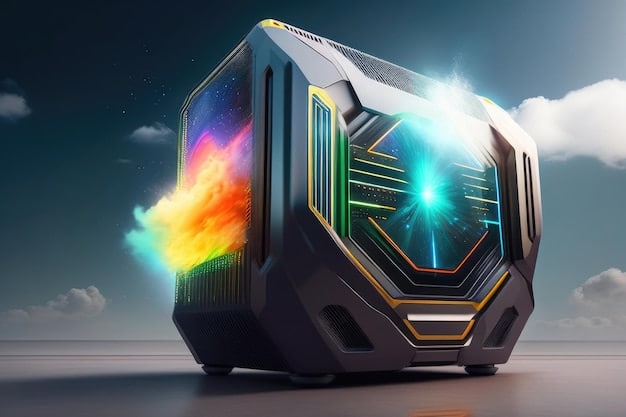
Upgrading your PC’s cooling system can potentially increase gaming performance by 15%, primarily by preventing thermal throttling and allowing components like the CPU and GPU to maintain higher clock speeds for longer durations.
Is your gaming rig feeling the heat? Can upgrading your PC’s cooling system increase gaming performance by 15%? The answer might surprise you, as keeping your components cool is crucial for optimal performance and preventing dreaded thermal throttling.
Understanding Thermal Throttling and Its Impact on Gaming
Thermal throttling is a mechanism built into modern processors and graphics cards to prevent them from overheating. When a component reaches a certain temperature threshold, it automatically reduces its clock speed and voltage to lower heat generation.
This reduction in clock speed directly translates to lower performance in games, resulting in reduced frame rates and stuttering. Therefore, understanding how thermal throttling affects your gaming experience is vital.
What Causes Thermal Throttling?
Several factors can contribute to thermal throttling. Ambient temperature, inadequate airflow inside the case, and the age and condition of your thermal paste all play a role. Dust accumulation on heatsinks and fans can also significantly reduce their efficiency.
How to Identify Thermal Throttling
Identifying thermal throttling can be done through monitoring software. Tools like HWMonitor, MSI Afterburner, or even built-in monitoring features in your GPU drivers can show you the temperature and clock speeds of your CPU and GPU during gameplay. Watch for sudden drops in clock speed accompanied by high temperatures.
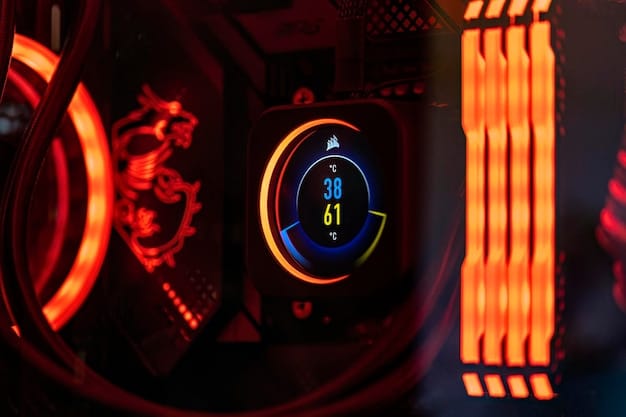
- Monitor CPU and GPU temperatures during gaming sessions.
- Look for sudden drops in clock speeds when temperatures rise.
- Use monitoring software to track thermal performance.
- Ensure adequate airflow within your PC case.
Thermal throttling directly impacts gaming performance by reducing frame rates and causing stuttering. By understanding the causes and how to identify it, you can take steps to improve your PC’s cooling system and prevent performance degradation.
The Basics of PC Cooling Systems
PC cooling systems are designed to dissipate heat generated by components like the CPU, GPU, and chipset. There are primarily two types of cooling systems: air cooling and liquid cooling.
Each type has its own advantages and disadvantages, making them suitable for different types of PC builds and user preferences.
Air Cooling
Air coolers use heatsinks and fans to draw heat away from components. Heatsinks are typically made of aluminum or copper and feature fins that increase the surface area for heat dissipation. Fans then blow air across the heatsink to carry the heat away.
Liquid Cooling
Liquid coolers, also known as water coolers, use a liquid coolant to absorb heat from components. The coolant is circulated through a loop that includes a pump, radiator, and fans. Liquid coolers are generally more efficient than air coolers at dissipating heat, but they are also more expensive and complex to install.
- Air coolers are more affordable and easier to install.
- Liquid coolers offer better cooling performance but are pricier.
- Consider your budget and cooling needs when choosing a system.
- Ensure proper installation for optimal cooling efficiency.
Choosing the right cooling system depends on your budget, the heat output of your components, and your comfort level with installation and maintenance. Both air and liquid cooling solutions can significantly improve your PC’s thermal performance and prevent throttling.
Air Cooling: Options and Effectiveness
Air cooling is the most common and affordable method for keeping your PC’s components cool. It involves using a heatsink and fan combination to dissipate heat away from the CPU, GPU, and other heat-generating components.
There are various types of air coolers available, each offering different levels of cooling performance and noise levels.
Stock Coolers
Stock coolers are the coolers that come included with your CPU. While they are adequate for basic computing tasks, they often struggle to keep up with the heat generated during heavy gaming sessions or overclocking.
Aftermarket Air Coolers
Aftermarket air coolers offer significantly better cooling performance than stock coolers. These coolers typically feature larger heatsinks, more heat pipes, and higher-quality fans. They are available in a range of sizes and price points to suit different budgets and cooling needs.
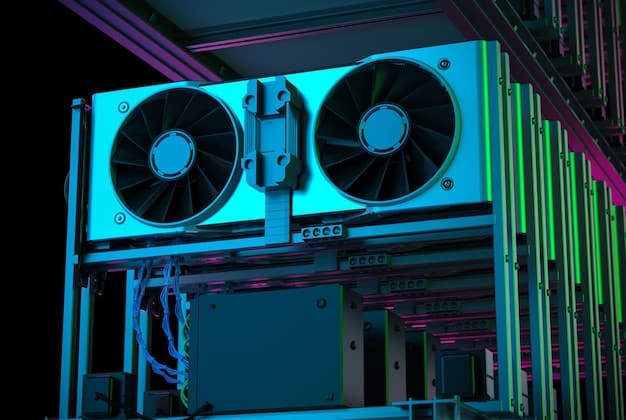
- Stock coolers are adequate for basic use but insufficient for gaming.
- Aftermarket air coolers provide better cooling performance.
- Consider the size and noise levels of aftermarket air coolers.
- Ensure the cooler is compatible with your CPU socket.
Upgrading to an aftermarket air cooler is a simple and cost-effective way to improve your PC’s cooling performance and prevent thermal throttling. It can result in lower temperatures, higher clock speeds, and a more stable gaming experience.
Liquid Cooling: Types and Benefits
Liquid cooling offers a more efficient and effective way to dissipate heat from your PC’s components compared to air cooling. There are two main types of liquid cooling systems: all-in-one (AIO) coolers and custom liquid cooling loops.
Each type offers unique advantages and is suitable for different levels of PC enthusiasts.
All-in-One (AIO) Liquid Coolers
AIO liquid coolers are self-contained units that include a pump, radiator, and fans. They are pre-filled with coolant and require no maintenance. AIO coolers are easier to install than custom loops and provide excellent cooling performance.
Custom Liquid Cooling Loops
Custom liquid cooling loops are more complex systems that allow you to cool multiple components, such as the CPU, GPU, and even RAM. These loops consist of a reservoir, pump, radiator, water blocks, and tubing. Custom loops offer the best cooling performance but require more technical knowledge and maintenance.
- AIO coolers are easy to install and require no maintenance.
- Custom loops offer superior cooling performance but are complex.
- Liquid cooling can significantly lower component temperatures.
- Consider the cost and complexity when choosing a liquid cooler.
Liquid cooling provides a superior cooling solution for demanding PC builds, offering lower temperatures and quieter operation compared to air cooling. Whether you choose an AIO cooler or a custom loop, liquid cooling can help you achieve optimal performance and stability.
How Cooling Impacts CPU and GPU Performance
The CPU (Central Processing Unit) and GPU (Graphics Processing Unit) are the two primary components that generate the most heat inside a PC. Effective cooling is crucial for maintaining their performance and preventing thermal throttling.
When these components overheat, their performance is automatically reduced to prevent damage, resulting in lower frame rates and stuttering in games.
CPU Cooling and Performance
The CPU is responsible for processing game logic, AI, and physics calculations. When the CPU overheats, it reduces its clock speed, which can significantly impact game performance. A good CPU cooler can maintain stable clock speeds, resulting in smoother gameplay.
GPU Cooling and Performance
The GPU renders the visuals in games, and its performance directly affects the frame rate. Overheating can cause the GPU to throttle, leading to lower frame rates and visual artifacts. An adequate GPU cooler ensures the GPU operates at its maximum potential, providing the best possible gaming experience.
- Effective CPU cooling ensures smooth gameplay and stable clock speeds.
- GPU cooling is crucial for achieving high frame rates and preventing visual artifacts.
- Both CPU and GPU cooling prevent thermal throttling.
- Investing in good cooling can improve overall gaming performance.
Proper cooling for both the CPU and GPU is essential for achieving optimal gaming performance. By keeping these components cool, you can prevent thermal throttling and enjoy a smoother, more responsive gaming experience.
Testing and Measuring Performance Improvements
To determine whether upgrading your PC’s cooling system leads to a 15% increase in gaming performance, it’s essential to conduct thorough testing and measurement.
This involves using benchmarking tools and monitoring software to compare performance before and after the cooling upgrade.
Benchmarking Tools
Benchmarking tools like 3DMark, Cinebench, and Unigine Heaven can provide quantitative data on your PC’s performance. These tools run standardized tests that measure CPU and GPU performance under various workloads. Comparing scores before and after the cooling upgrade can reveal any performance improvements.
Monitoring Software
Monitoring software like HWMonitor and MSI Afterburner can track CPU and GPU temperatures, clock speeds, and frame rates during gameplay. This data can help you identify whether thermal throttling is occurring and how much the cooling upgrade has improved thermal performance.
- Use benchmarking tools to measure CPU and GPU performance.
- Monitor temperatures and clock speeds during gameplay.
- Compare performance before and after the cooling upgrade.
- Look for improvements in frame rates and stability.
While a 15% increase in gaming performance is a specific target, the actual improvement can vary depending on the initial cooling solution and the specific games being played. However, with proper testing and measurement, you can effectively assess the impact of the cooling upgrade on your gaming experience.
| Key Takeaway | Brief Description |
|---|---|
| 🌡️ Thermal Throttling | Occurs when components overheat, reducing performance. |
| ❄️ Cooling Solutions | Air and liquid cooling options available for PCs. |
| 📈 Performance Impact | Better cooling prevents throttling, boosting gaming FPS. |
| 📊 Testing Methods | Benchmark and monitor to quantify performance gains. |
Frequently Asked Questions
▼
Not necessarily. The actual performance increase depends on your current cooling, ambient temperature, and the specific game. A 15% boost is possible but not guaranteed.
▼
Liquid cooling generally offers better thermal performance, but it’s also more expensive and complex. High-end air coolers can often match or come close to AIO liquid coolers’ performance.
▼
Use monitoring software like HWMonitor or MSI Afterburner to track temperatures and clock speeds during gaming. If you see temperatures near the TJ Max and clock speeds dropping, you’re likely experiencing thermal throttling.
▼
The “pea-sized dot” method is generally recommended. Apply a small amount of thermal paste in the center of the CPU heat spreader. The pressure from the cooler will spread it evenly.
▼
It depends on your environment, but cleaning every 3-6 months is a good practice. Dust buildup can significantly reduce cooling efficiency. Use compressed air to clean heatsinks and fans.
Conclusion
In conclusion, while achieving a precise 15% increase in gaming performance solely through upgrading your PC’s cooling system is not guaranteed, the benefits of improved cooling are undeniable. By preventing thermal throttling, maintaining stable clock speeds, and extending the lifespan of your components, a better cooling solution can significantly enhance your overall gaming experience.
